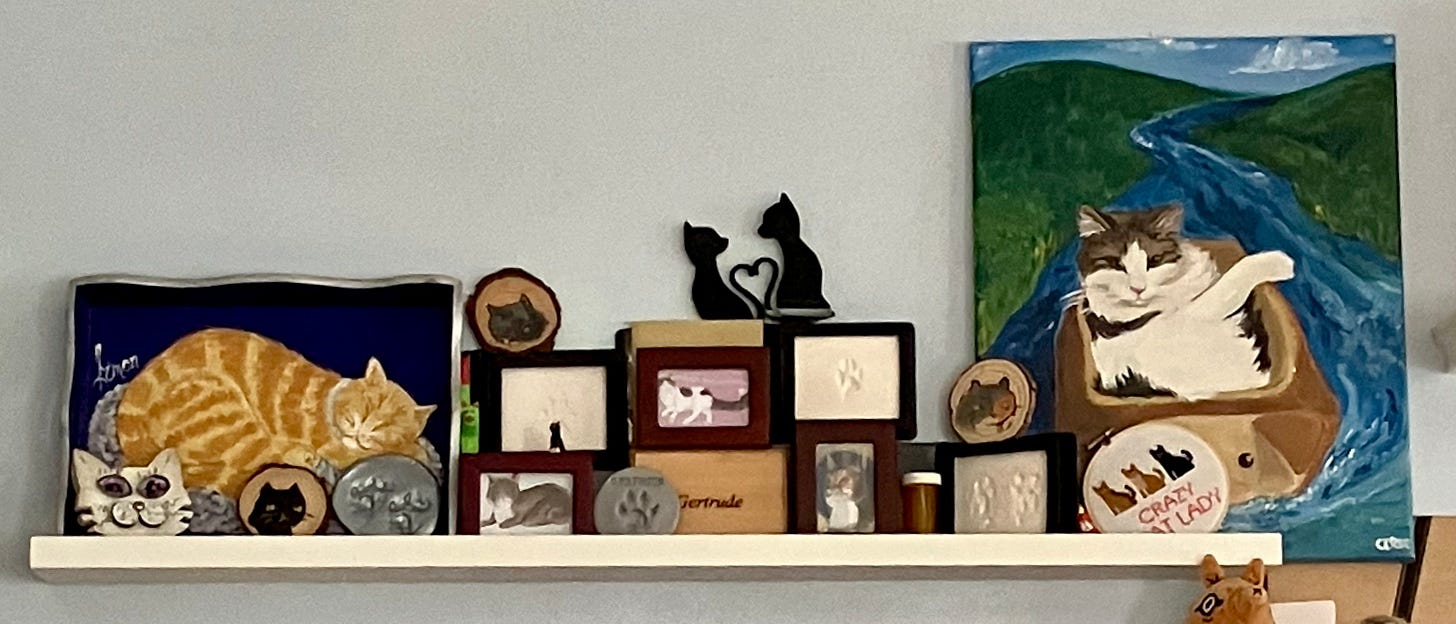Dear Friends,
In her Instagram post on reasons to love the Church calendar, Danielle Hitchen of Catechesis Books describes all of the ways that living into sanctified time can bless our days – and they’re really quite charming: Epiphany king cakes and 12th Night parties and bonfires for the Feast of John the Baptist. There’s a lot of fun to be had. But as the Feast of St. Francis approaches, I’m thinking about some of the less fun pieces of what is often one of our favorite opportunities to gather.
The Feast of St. Francis is marked for many churches by the Blessing of the Pets. Sometimes it’s a full service, sometimes a brief liturgy on the lawn. Often there is an opportunity to donate supplies to a local animal shelter or to make enrichment materials for shelter pets. This year, our diocesan bishop is retiring and they’re throwing a celebration of his ministry at the New England Aquarium on the Sunday when most of us celebrate the Feast of St. Francis, so many here will celebrate with more aquatic animals than usual. It’s festive and connects us with both domestic and wild animals, common and endangered. But St. Francis is so much more.
The Pains And Promises of St. Francis
Francis of Assisi was, in addition to his love of animals and the natural world. He is also the founder of a religious order committed to both personal and corporate poverty, the purported inventor of our Christmastide creche scenes, a great advocate for peace, and a man who spoke movingly about seeing God in our neighbors.
Francis knew voluntary poverty, yes, but he was also familiar with spiritual and physical wounds. He developed stigmata following a vision of seraphim, as well as an infection that caused damage to his eyes, leading to eventual blindness (his eyes were burned shut after multiple treatments failed). So, what does all of this have to do with how we celebrate him?
My relationship to St. Francis’s story feels very different the more I learn about the work of caring for animals. My first pet (well, besides some fish) came from a large, well-respected shelter in Long Island. My first cat literally was rescued by my family, along with the rest of her litter, from our backyard (we eventually, along with our neighbors, captured the mama cat and had her spayed). Since then, my wife and I have fostered probably in the area of 100 cats and, including that first childhood cat and our current pets, have permanently cared for 9 cats together. There was a 10th who was meant to be a foster but who spent over six months with us as he became a foster-to-hospice case; his footprints share a spot on our cat shrine with the cats who were more properly ours.
Now that my wife has crossed the halfway mark in her veterinary education and her work has shown it is clearly headed in the direction of what is sometimes called “public access” veterinary medicine, I’ve been learning even more about how St. Francis’s story fits into this story. Public access vet med refers not just to public shelters or TNR programs. It’s low-cost veterinary care like the student-run program that operates through the vet school, staffed by third and fourth year vet students and technical high school students training to be veterinary technicians. It’s the partnership they have with our town’s public housing, where veterinarians and vet students visit each site twice a year to examine any pets the residents have and refer them for additional, affordable care as needed. It’s outreach to unhoused people and their pets, these animals who are often one of the only anchors in their unstable lives. It’s a big picture.
And so, when I think of how we celebrate Francis of Assisi, it’s about more than the animals, especially more than our own animals who are not just loved, but doted on. My house looks like I have at least one toddler instead of five cats, there are so many toys and accoutrements scattered everywhere. They are already more blessed than their fuzzy little heads will ever know.
As your community or household plans to mark the Feast of St. Francis, I invite you to consider a few things:
How is my community meeting the needs of the people and animals who are most vulnerable? What programs exist and how can I help? At the Cummings School of Veterinary Medicine at Tufts this looks like many of the programs I’ve described above, as well as financial support for specialist care in that hospital system, via the Lerner Fund. (you can give here under the category “Veterinary Medical Care” but I also encourage you to locate the systems that exist near you! Tufts is where a large portion of specialty care and care for exotic pets - basically anything besides dogs and cats - happens for residents across New England.)
What do the shelters and rescues near me need to best care for their animals? Pet food drives and the like are fantastic but if you’re not a pet owner or you have a fairly hearty animal, you may not know how important it is for animals to generally consume the same kind of food. Many shelters have wishlists that allow you to send them exactly what they need, rather than trying to guess. Sometimes it’s really boring stuff like bleach – or really silly stuff like Easy Cheese (great for giving dogs their medicine!), but you won’t know if you don’t check!
Learn the lingo! If you’ve been here for even a few minutes, you know I’m a big fan of precise communication, and this is another place where this really counts. Many of us have been taught to demonize local municipal shelters systems, using the language of “kill shelters” and this is frequently a disservice to those programs and their work – and ultimately a hindrance to the good that they do.
Let me tell you a little story about this language. Year ago, my wife worked for NYC Animal Control. Not the kind of place that has a great reputation, right? People were often afraid to take stray animals there for fear they would be euthanized due to space concerns or costs – and it simply wasn’t true. And, by the statistical measure of “95 percent live adoptions/placement/discharges” that classifies a shelter as “no kill,” NYC Animal Control would never meet the criteria, for reasons that had nothing to do with cats and dogs and hamsters. Your local animal control is typically responsible for dealing with injured squirrels, limping deer, snapping turtles that have been hit by cars.
They’re also responsible for confiscating invasive species – my wife tells a story about the time they took in a kiddie pool full of invasive crabs. And the only thing to be done with those crabs was to euthanize them. They couldn’t be released because they would harm the regional ecosystem. But euthanizing over 100 crabs sure was going to hurt their statistics.
The language of kill shelters emerged decades ago before there was increased awareness around the importance spaying/neutering pets. There was a real “overpopulation” problem. Today, though, healthy dogs and cats are far more likely to be shipped out of state than they are simply to be killed, and yet these reputations remain. Learning how these terms function and what they mean is an essential part of caring for animals and your neighbors in the animal care world.
When I think about St. Francis’s vow of poverty, I also think about the fact that although conditions are improving, shelter medicine and animal control professionals (and even licensed veterinary technicians) are frequently underpaid. Most support staff could make more money working at Target than providing care for animals, but they do this because they are passionate about this work. Fighting for better pay and working conditions – for justice for these workers – can also be a way of engaging with St. Francis’s legacy. These aren’t people who intended to take vows of poverty and they shouldn’t have to.
Instruments of Peace
Honoring St. Francis means more than just blessing the animals we already love so much. I am taken by his prayer – Make Me An Instrument of Your Peace.
Lord, make me an instrument of your peace, where there is hatred, let me sow love; where there is injury, pardon; where there is doubt, faith; where there is despair, hope; where there is darkness, light; and where there is sadness, joy.
O, God, grant that I may not so much seek to be consoled as to console; to be understood as to understand; to be loved as to love; for it is in giving that we receive; it is in pardoning that we are pardoned; and it is in dying that we are born to eternal life. Amen.
I’m also into The Brilliance’s fresh take on it in “Open Up,”
The Prayer of St. Francis isn’t about blessing pets or giving to animal shelters. It’s about mending the world. It is about unity. It is about finding grace by offering it. Giving and blessing, in any fashion, will bring us closer to grace, but I encourage you to look for where we can mend division, sowing love where there is hared. Where we can bring joy in the midst of sadness. Where we can offer pardon for injury. St. Francis may have preached to the birds, but he spoke to us too and I think sometimes we forget to listen.
I hope you’ll share with me where St. Francis’s life has spoken to you. I feel so fortunate to get to come close to some of the complex ways that doing justice for people and animals can be intimately connected.
Resource Round-Up
Are you the parent of a child/children under ages 0-12? “Dr. Dana Kennamer and Dr. Jennifer Schroeder, faculty at Abilene Christian University who study children’s spiritual formation, are doing a study, entitled “Listening to Parents,” that examines (1) parents’ perceptions of their children’s spirituality and (2) what they believe is essential for faith development.” You can learn more and participate in this study here. (The researchers here are friends of one of my dear colleague’s from the Godly Play equity world, which is all I need to know to trust their work!)
No one does supplemental content like the publishing team behind Glenys Nellist’s books, and this time we’ve got liturgy. Timed to go with her new book Gathered at the Table and the upcoming World Communion Sunday, they’re shared this simple liturgy. The activity kit for Gathered at the Table is also available now. The pictures from her baptism book are a favorite in my parish’s Prayground.
I’ve shared a few other resources from ReFocus Ministry, and I’m consistently impressed by their view of children’s place in our communities. I’m looking forward to checking out their new free family discipleship toolkit on the theme of loving your neighbor.
Look, I don’t have any big desire to promote Amazon, but I also know we need to be realistic about our program budgets. Amazon Big Deal Days are October 8-9 so make your wish list and cross-check it when the deals launch. I did a lot of back-to-school shopping for my program during the summer Amazon Prime event, but I know a number of my colleagues missed that July shopping window. If you get ready now, you can grab what you need quickly and at steep discounts in a few weeks!
I hope we’re all finding our rhythms as our programs get settled for the season. What do you need next to stay rooted in this work? I think I’m finally slowing down instead of flying off in all directions, and it’s a good feeling.
Peace,
Bird




